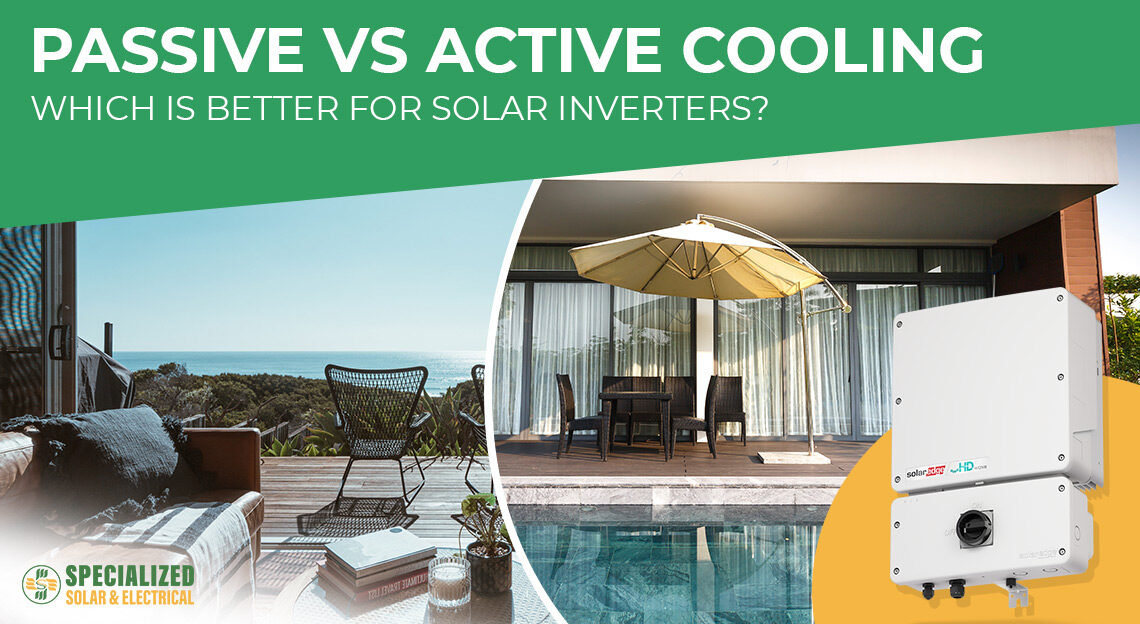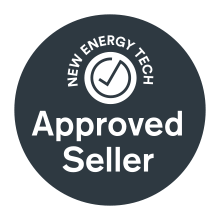A solar inverter contains complex electronics that handle the conversion of DC electricity from solar panels to AC power for use in your home.
And, like anything electronic, a solar inverter doesn’t like getting too hot.
That’s why solar inverters need to be installed in a sheltered location, ideally on a south-facing wall or in a carport. The inverter needs to be kept out of direct sun so it can produce maximum power and not wear out.
When you’re shopping around for a solar inverter, one major difference you’ll find is the way the inverter is cooled. There are two different methods:
- Active cooling
- Passive cooling
Solar inverters that are actively cooled use fans (normally a couple of fans), whereas passive cooling relies on natural convection and a heat sink.
For many years, the received wisdom has been that active cooling is the best way of keeping the temperature of a solar inverter at a consistent operating temperature. Companies like Fronius bet heavily on active cooling and included fans in all their inverter models (as they continue to do to this day).
But solar technology keeps getting better. What was true a few years ago, isn’t necessarily the case today.
On this post, we’ll look at the advantages of passive cooling versus active cooling, so you have the facts at your fingertips when you’re choosing a solar inverter for your home.
On this blog:
- What happens to inverters when they get hot?
- Advantages of passive cooling vs active cooling
What happens to inverters when they get hot?
Solar inverters are designed to operate within a specified temperature range. If you want to know the operating temperature range for any inverter brand, get hold of its datasheet and look for the ‘operating ambient temperature range’ (or words to that effect).
For the Sungrow single-phase hybrid inverter, for example, the operating ambient temperature range is -25 ℃ to 60 ℃ (which is pretty impressive!).
When the ambient temperature (i.e., the temperature of the immediate surroundings) exceeds this range, the inverter may switch off or work in ‘go slow’ mode.
Of course, this isn’t good for the output of your system. But ask yourself: how often is this going to happen?
Sure, our summers are getting hotter, but 60 ℃ days are still the stuff of apocalyptic movies (thank goodness!)
However, heat is also generated by the inverter as it converts DC electricity to AC power, and this adds to the ambient temperature.
To keep the inverter from overheating, heat is dissipated in one of two ways:
- using fans (active cooling) and/or
- a heat sink in the inverter enclosure (passive cooling).
Heat levels must not be allowed to go too high because materials within the inverter will start to deteriorate. Fortunately, semiconductors used in solar inverters are resilient and can endure high temperatures without adverse effect (up to a point). However, metal components may wear out and insulation will become brittle.
To ensure this doesn’t happen, inverters have built-in programming to ‘de-rate’. De-rating means reducing the amount of power generated when pre-set temperature levels are reached. The higher the temperature, the greater the level of de-rating, until at a certain point the inverter will switch off completely.
Annoyingly, most inverter datasheets don’t publish the de-rating statistic. You have to dig deep into the product manuals to find it (if you are lucky and very persistent). Why this isn’t a requirement for all datasheets seems strange.
But, according to industry experts, most quality inverters don’t start de-rating until the ambient air temperature rises over 45 – 50 ℃.
This is an improvement compared to five or ten years ago, when solar inverters would start de-rating at much lower temperatures. So, whilst you obviously don’t want to run the risk of your inverter de-rating, the number of days a year when it’s going to be hot enough to get your inverter cooking at 50℃ are going to be few and far between (unless you live in the desert).
And de-rating may not be an issue at all, if you get your inverter installed in a shaded position or under cover. That’s why choosing a reputable, fully accredited solar company like Specialized Solar & Electrical is your biggest insurance against future mishaps caused by your solar inverter getting cooked by the sun!
Advantages of passive cooling vs active cooling
Here is a summary of six advantages of passive cooling versus active cooling for solar inverters.
| Passive cooling | Active cooling |
|---|---|
Whisper quite
|
Much noisier
|
Very reliable – no moving parts
|
Fairly reliable – but includes moving parts
|
Higher efficiency
|
Lower efficiency
|
Less expensive
|
More expensive
|
De-rating: a non-issue
|
De-rating: a non-issue
|
Longer lifespan
|
Good lifespan – but not guaranteed
|
Rounding up
If you want a solar inverter that’s quiet and won’t keep you or the neighbours awake at night, get an inverter with passive cooling. You won’t be compromising on performance, reliability, or power output. And you’ll be saving yourself a bit of cash too, compared to most fan-cooled inverters.
Get in touch
If you’ve got any questions after reading this article, get in touch.
We stock and install leading brand solar inverters including Sungrow and Fronius – because at the end of the day, it’s your choice.
We’re here to help you choose the best solar power system for your home and budget.
It’s a great time to go solar – so contact us today!












